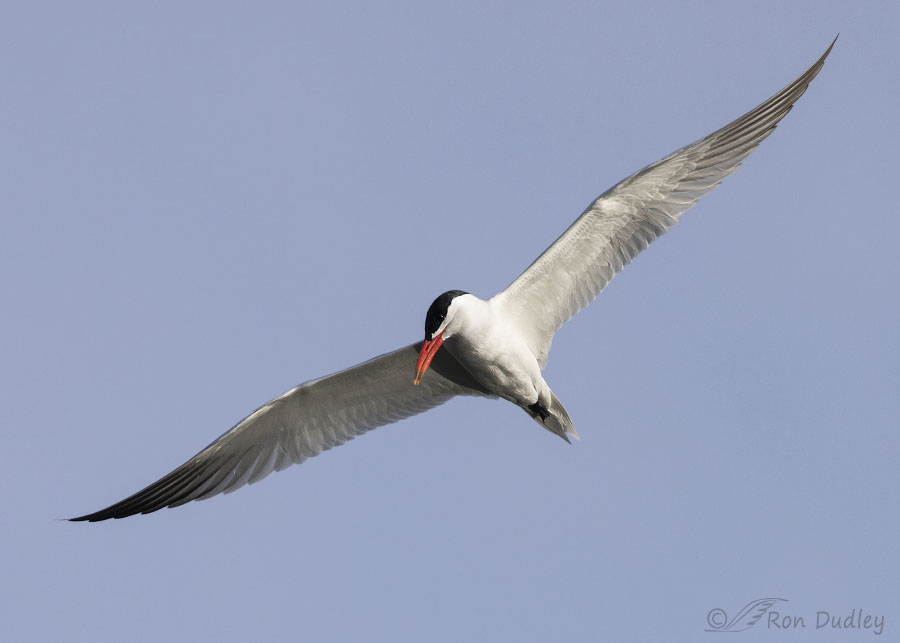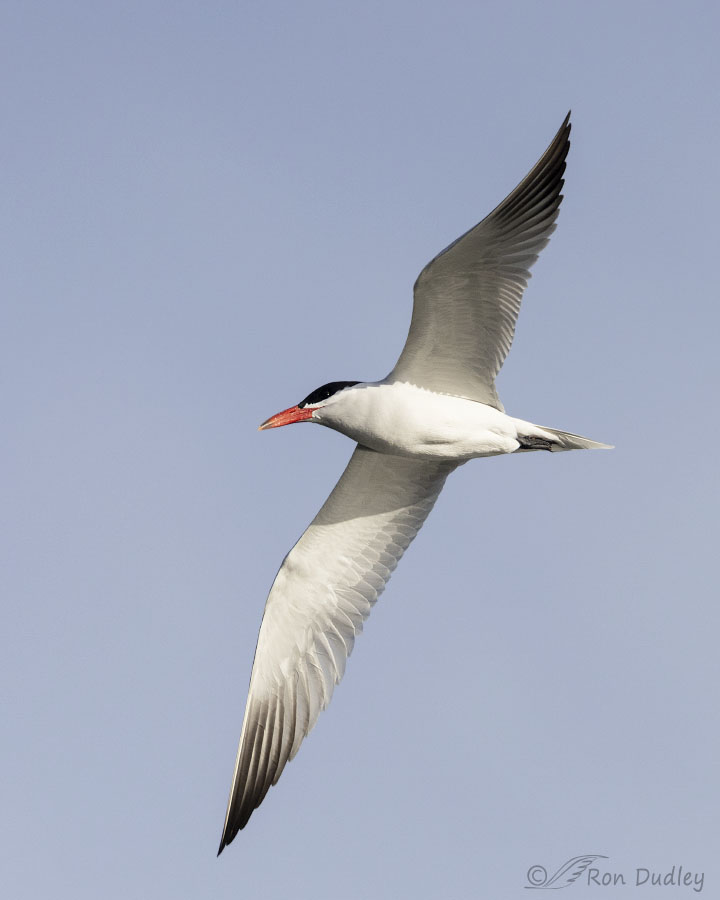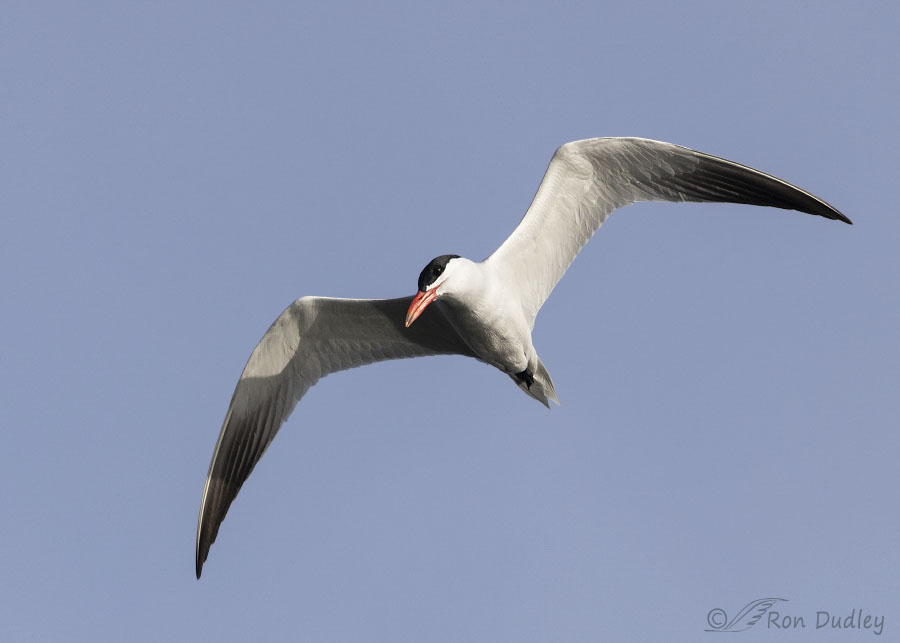Yesterday I finally got some pretty decent flight shots of the world’s largest tern.

1/6400, f/5.6, ISO 800, Canon R5, Canon EF500mm f/4L IS II USM + 1.4 tc, not baited, set up or called in
On several recent mornings I’ve tried to photograph Caspian Terns in flight but until yesterday I’ve always been stymied by circumstance. As they fished they always made counterclockwise rotations around the pond and by the time they got close enough to me they were in sidelight with their face in shade. That unfortunate fishing flight pattern never failed.
Until yesterday when, for some unknown reason (breeze coming from a different direction?), they occasionally turned to the southwest for a few moments as they got close to me, before turning back to the southeast. And that fortunate ‘turn’ of events (bad pun intended) allowed me to get a few shots with light on their face while they were ‘close enough’.

1/6400, f/5.6, ISO 800, Canon R5, Canon EF500mm f/4L IS II USM + 1.4 tc, not baited, set up or called in
One of the other problems I faced, one typical of terns of various species in flight, was getting light in their eyes. That black eye, set in the jet black feathers of the tern’s cap, is the epitome of a “photon-sucking” situation that makes getting a catch light in the eye very difficult. I got dozens of photos lacking a catch light that were otherwise pretty good

1/6400, f/5.6, ISO 800, Canon R5, Canon EF500mm f/4L IS II USM + 1.4 tc, not baited, set up or called in
Caspian Terns, the largest terns in the world, are also distinguished by their harsh, raspy vocalizations and massive coral red bills. They’ve been described as “ the king of all the terns… the dominant ruling spirit in the colonies… the largest, strongest and fiercest of the terns.”
In this photo that big red bill stands out nicely against the shaded underwing.
The last problem I faced with the terns at the pond was that they were always flying too high for the types of flight shots I prefer. So for me this season, flight shots of Caspian Terns in flight are still a work in progress.
To get any better photos of them I’ll probably have to get lucky with a tern immediately after a dive for a fish.
Ron
Note: The distribution of Caspian Terns in North America is spotty and scattered so I suspect many of my readers have never seen them. If you’d like to become more familiar with them, the video I’ve linked to in the last sentence in my post is pretty darn good – especially regarding ‘plunge-diving’.


No clipped wings on a bird with a four foot wingspan.
Eyecatch with black eyes and black head.
Nice detail overall.
Well done, if I may say so.
These guys are just gorgeous, glad you were able to capture some photos that do them justice. And thanks, too, for that video link, that’s some stellar fishing AND videography!
Chris, I enjoyed the video enough to watch it several times.
Great photos. I like the head turn in two of the shots but the middle photo I like best, I love the composition.
April, that wing position lends itself to a vertical composition.
A very fortunate tern of events. Gorgeous pictures.
Thank you, Penny.
Never seen. Never heard of. What a huge bird! Wow. Thank you, professor. You’ve widened my world.
“You’ve widened my world.”
Good. Thanks, Arwen.
Gorgeous, Ron! And thanks for the video link.
That video link was a last minute addition, Carolyn. I’m glad I included it.
Plunge diving is an entirely accurate term.
Yet another bird I do not know. Yet another day started with education and delight.
thank you. Muchly.
You’re welcome, EC. Muchly.
If you wish to see many of these birds come to the mouth of the Columbia River. There, you will find Tern Island, an island of dreg spoils. And on Tern Island you will find what has become the largest colony of Caspian Terns in the world. But be aware. Many locals are not happy with these birds. They blame them and the cormorants for the large decrease of salmon runs. It’s easier to blame them than to deal with the more complex underlying causes. Wildlife officials have tried for many years to attract the terns elsewhere. Artificial islands were created, one was here at a reservoir west of Eugene and another in San Francisco bay. These had very limited sucess and there are still many terns on the Columbia. I find them a magnificent sight and your photos show them very well.
So interesting, Dan. And yes, easier to blame the birds for lack of salmon than the underlying complex human-caused issues (dams, etc)
Dan, I knew the cormorants were unpopular along the Columbia but I’m sad to learn that these terns are in the same boat.
Oh how lovely. Haven’t seen these in 40 years.
Thanks, Sallie.
Before your post today, I’d never seen a Caspian Tern, and upon seeing their elegant wingspan, I thought,”The designers of glider aircraft must have
modeled them on very long and slender wings of terns! ” I could have
watched that video all morning– mesmerizing IS the word, and the sound of the
water completed the enchantment !
Kris, it’s really fun to watch Caspian Terns and Forester’s Terns fishing and diving at the same time. So far this year I haven’t seen any of the Forester’s.
I hope your luck in getting flight shots of these birds continues to take a tern for the better.
Thank you for sharing the video clip. The dive fishing reminds me of being mesmerized every time I see Brown Pelicans performing similar maneuvers.
Thanks for the good wishes, Marty. Caspian Terns are some of the best flyers, and divers, I photograph.
Excellent photos in spite of the lack of catch eye. You can see how difficult it is to get the light in the eye. I think you are right about what conditions would best give you a chance of getting the light.
PS: Love the pun – If the Tern turns the right way it will be Ron’s turn to get the catch eye.
Thanks, Everett. Actually there’s a catch light in all three of these photos. But in many of the others there wasn’t.
Nice! Beautiful bird. The heavy bill must be useful for fishing. Have never seen one. Video tells how large LARGE is – I wouldn’t have gotten that from the photos or, unless, I’d looked them up. Must be a good sized pond for them to be working it!
Beautiful bird. The heavy bill must be useful for fishing. Have never seen one. Video tells how large LARGE is – I wouldn’t have gotten that from the photos or, unless, I’d looked them up. Must be a good sized pond for them to be working it! 
Pair of Sandhill Cranes in a field “up top” yesterday on my way to town as they were last week. A few flying over or short stopping it in our area the past few years.
Pond & filter got thawed yesterday – warmer this next week.
Judy, the range map I’m looking at doesn’t show Caspian Terns in MT.
Then it sounds like you saved the water pump, Congrats,
Yep – pump is fine – filter will have to recycle after being “sitting” for several days and partially freezing. Time and patience – the latter isn’t one of my long suites!
Beautiful captures of this magnificent tern. I saw my first of the year (at least 7) in Kingston Ontario (eastern end of Lake Ontario) yesterday. In Ottawa (my home) we generally get a couple in migration, but nice to them in numbers. They are magnificent flyers!
“They are magnificent flyers.”
They sure are, Sheila.
Most days there’s been only one tern at this location but yesterday there were 4 or 5 of them fishing the pond.